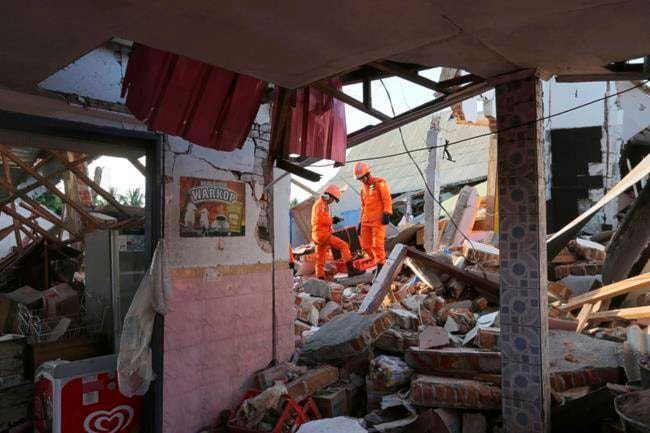A powerful earthquake flattened houses and toppled bridges on the Indonesian tourist island of Lombok, killing at least 98 people and shaking neighbouring Bali, as authorities said Monday that rescuers still hadn’t reached some devastated areas and the death toll would climb.
It was the second deadly quake in a week to hit Lombok. A July 29 quake killed 16 people and damaged hundreds of houses, some of which collapsed in Sunday evening’s magnitude 7.0 temblor, killing those inside.
National Disaster Mitigation Agency spokesman Sutopo Purwo Nugroho told a news conference that damage was “massive” in northern Lombok. In several districts, more than half the homes were destroyed or severely damaged.
The ruins of a mosque that collapsed in Lading-Lading village while people prayed inside was being pulled apart by a backhoe in search of victims.
Some areas still hadn’t been reached as of midafternoon, with rescuers battling collapsed bridges, electricity and communication blackouts and damaged roads blocked with debris.
Nugroho said the death toll had risen to 98, after warning earlier that it would “definitely increase.” More than 230 people were seriously injured. Thousands of homes and buildings were damaged and 20,000 people were in temporary shelters.
The quake, measured at magnitude 7.0 by Indonesian authorities and 6.9 by the U.S. Geological Survey, struck at a shallow depth of 10.5 kilometres (6 miles) in the northern part of Lombok. Shallow quakes tend to cause more damage than deeper ones.
Wisatawan asing dsn domestik menunggu evakuasi dari Gili Trawangan, Gilingan Air dan Gili Meno Lombok Utara. Terbatasnya kapal menyebabkan evakuasi bertahap. Tim SAR akan menambah kapal. pic.twitter.com/EZKqwLnQjQ
— Sutopo Purwo Nugroho (@Sutopo_PN) August 6, 2018
“We were sitting there having dinner at about 7 o’clock last night, we just felt a really big sort of shaking and the lights went off and everyone just ran,” Australian tourist Kim Liebelt said as he waited with other travellers for a flight out at Lombok’s international airport.
“And then the roof started falling down on us, rocks and rubble and then just everyone running to get away,” he said.
Videos showed screaming people running in panic from a shopping mall and a neighbourhood in Bali where parked vehicles swayed. On Lombok, soldiers and other rescuers carried injured people on stretchers and carpets to evacuation centres. Many victims were treated outdoors because hospitals were damaged.
“People panicked and scattered on the streets, and buildings and houses that had been damaged by the previous earthquake had become more damaged and collapsed,” Nugroho said.
The quake triggered a tsunami warning, and frightened people poured out of their homes to move to higher ground, particularly in North Lombok and Mataram, the capital of West Nusa Tenggara province. The warning was lifted later Sunday after only small waves were recorded.
“When it happened, we stood with residents in the middle of the street and watched houses collapse around us,” said Yustrianda Sirio, supervisor of a group of university students from Java doing a community service program in East Lombok. “Many of us screamed hysterically.”
He said the group had already been staying in tents after the July 29 quake but now officials had told them to return to Java.
“We really want to stay here to help the villagers,” he said.
On Gili Trawangan, one of three popular vacation islands near Lombok, thousands of tourists and local residents spent the night on a hill fearing a tsunami, said British visitor Saffron Amis.
“There was a lot of screaming and crying, particularly from the locals,” said Amis, from Brighton. “We spoke to a lot of them and they were panicking about their family in Lombok. It was just a lot of panic because no one knew what was happening.”
Thousands of people are now trying to get off the island, she said, describing the mood as both sombre and panicked.
Hundreds of people packed a sliver of brilliant white beach on the 16-square kilometre (6-square mile) island, shouting at rescue personnel trying to ensure an orderly evacuation, video and photos supplied by the local water police showed.
Nugroho said authorities had deployed three ships to evacuate people. Reports that seven Indonesian tourists died on the island have not been confirmed, he said.
Like Bali, Lombok is known for pristine beaches and mountains. Hotels and other buildings in both locations are not allowed to exceed the height of coconut trees.
Indonesia is prone to earthquakes because of its location on the Pacific “Ring of Fire,” an arc of volcanoes and fault lines in the Pacific Basin. In December 2004, a massive magnitude 9.1 earthquake off Sumatra island triggered a tsunami that killed 230,000 people in a dozen countries.
Australian Home Affairs Minister Peter Dutton, in Lombok for a regional security meeting, said he and his delegation were eating dinner in their hotel’s 12th floor restaurant when the quake struck, plunging the building into darkness and throwing people to the floor.
“Mate, we were knocked certainly to the floor. It was the violence of the shaking of the building — was pretty dramatic,” he said in a radio interview. “Everyone’s a bit shaken, but all well, but people out in the villages or elsewhere haven’t been so lucky, unfortunately.”
The Bali and Lombok airports have remained open.
Model Chrissy Teigen, who was in Bali with singer-husband John Legend and their two children, live-tweeted the shaking.
“Bali. Trembling. So long,” Teigen tweeted to her 10.6 million followers.
Several hours later, she asked news organizations not to write more stories about her lively stream-of-consciousness tweets, suggesting media share information to help those who need it instead.
Kotarumalos reported from Jakarta, Indonesia. Associated Press writer Stephen Wright in Jakarta contributed to this report.
Ros Idin And Ali Kotarumalos, The Associated Press
